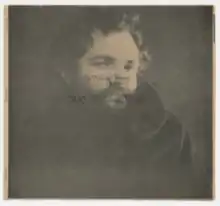Trio for Strings
Trio for Strings is a 1958 composition for violin, viola, and cello by American composer La Monte Young. It consists almost entirely of sustained tones and rests,[1] and represents Young's first full embrace of "static" composition.[2] It has been described as a central work of musical minimalism.[3]

History
Young composed the Trio as a recent college graduate in Los Angeles, imagining it as an impractically lengthy piece.[3] He ultimately reduced it to an hour for the first public presentation of his work.[3] The piece is indebted to Arnold Schoenberg's 12-tone technique and the late works of Anton Webern,[4] but was also influenced by Young's fascination with the long tones of Japanese gagaku and Indian raga.[3] It was Young's final serialist composition.[5] A set of four notes which recurs in the piece became known as the "Dream Chord" and would be explored further in Young's subsequent works.[3]
Young has never released any recordings of the Trio or published the score, making it difficult to hear aside from bootlegs circulated privately.[3] Since 1986, he has worked with cellist Charles Curtis to develop alternate versions of the piece.[3] In 2005, Young premiered a new "Just Intonation Version" of the Trio for a sextet, performed by the Theatre of Eternal Music String Ensemble under the direction of Curtis.[6] A series of 2015 performances extended the piece to three hours in length.[3]
Legacy
The composition has been described as an "origin point for minimalism."[3][7] The New Yorker called it "a sensuous and transcendent work" and "for many, the seminal work of musical minimalism."[8] Author Edward Strickland called it "the first work in full-blown musical minimalism" following Young's transitional pieces for Brass (1957) and for Guitar (1958).[9] David Paul of Seconds stated that the piece, "with its silences and long tones, paved the way for music based on tonality, drone and infinite time spans, brushing aside elaborate formal development in favor of the contemplation of pure sound."[10] The composition precipitated Young's 1960s improvising ensemble the Theatre of Eternal Music and his development of Dream House environments with Marian Zazeela.[3]
Artist Andy Warhol attended the 1962 première of the piece along with film-maker Jonas Mekas, who claimed that that Warhol's static films were directly inspired by the performance.[11][12] Composer Terry Riley credited the piece with paving the way for his influential 1964 composition In C, stating that "What La Monte introduced was this concept of not having to press ahead to create interest. He would wait for the music to take its own course."[13] According to Young himself, "Nobody ever took an interest in writing sustained tones without melodies over them before me."[3]
See also
References
- Strickland, Eric (2001). he New Grove Dictionary of Music and Musicians.
- "MELA: Trio for Strings, La Monte Young, The Theatre of Eternal Music String Ensemble". Mela Foundation. Retrieved 28 October 2020.
- Robin, William. "La Monte Young Is Still Patiently Working on a Glacial Scale". The New York Times. Missing or empty
|url=(help) - "MELA: Trio for Strings, La Monte Young, The Theatre of Eternal Music String Ensemble". Mela Foundation. Retrieved 28 October 2020.
- "MELA: Trio for Strings, La Monte Young, The Theatre of Eternal Music String Ensemble". Mela Foundation. Retrieved 28 October 2020.
- "MELA: Trio for Strings, La Monte Young, The Theatre of Eternal Music String Ensemble". Mela Foundation. Retrieved 28 October 2020.
- Nechvatal, Joseph. "Biography: Flawed Composition". Brooklyn Rail. Retrieved 7 October 2020.
- "La Monte Young's "Trio for Strings"". The New Yorker.
- Strickland, Eric (1993). Minimalism:Origins. Indiana University Press.
- Paul, David (1999). Seconds. Missing or empty
|title=(help) - Husslein 1990
- Blake Gopnik, Warhol: A Life as Art London: Allen Lane. March 5, 2020. ISBN 978-0-241-00338-1 p. 319
- Duckworth, William (1995). Talking Music. New York: Schirmer Books.